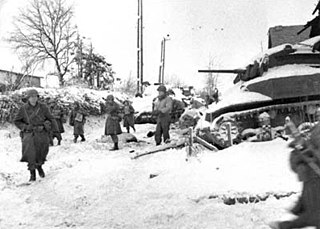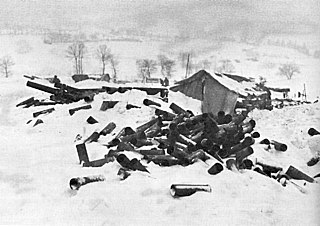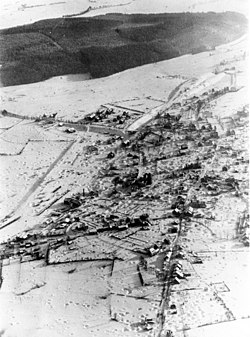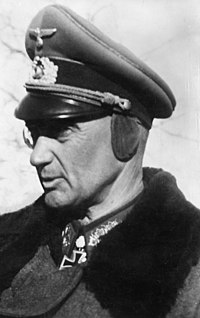Related Research Articles

The Battle of the Bulge, also known as the Ardennes Counteroffensive, was a major German offensive campaign on the Western Front during World War II which took place from 16 December 1944 to 25 January 1945. It was launched through the densely forested Ardennes region between Belgium and Luxembourg towards the end of the war in Europe. The offensive was intended to stop Allied use of the Belgian port of Antwerp and to split the Allied lines, allowing the Germans to encircle and destroy the four Allied forces and cause the Allies to negotiate a peace treaty in the Axis powers' favor.

Karl Rudolf Gerd von Rundstedt was a German field marshal in the Wehrmacht of Nazi Germany during World War II.

Günther Adolf Ferdinand von Kluge, also known as Hans Günther von Kluge, was a German field marshal during World War II who held commands on both the Eastern and Western Fronts. He commanded the 4th Army of the Wehrmacht during the invasion of Poland in 1939 and the Battle of France in 1940, earning a promotion to Generalfeldmarschall. Kluge went on to command the 4th Army in Operation Barbarossa and the Battle for Moscow in 1941.

The Allied advance from Paris to the Rhine, also known as the Siegfried Line campaign, was a phase in the Western European campaign of World War II.

The 12th SS Panzer Division "Hitlerjugend" was a German armoured division of the Waffen-SS during World War II. The majority of its junior enlisted men were drawn from members of the Hitler Youth, while the senior NCOs and officers were from other Waffen-SS divisions.
The 7th Army was a World War II field army of the German land forces.

5th Panzer Army was the name of two different German armoured formations during World War II. The first of these was formed in 1942, during the North African campaign and surrendered to the Allies at Tunis in 1943. The army was re-formed in France in 1944, fought in Western Europe and surrendered in the Ruhr pocket in 1945.

The Führerbegleitbrigade was a German armoured brigade and later an armoured division (Panzer-Führerbegleitdivision), in World War II. It grew out of the original Führer-Begleit-Battalion formed in 1939 to escort and protect Adolf Hitler at the front. It was formed in November 1944 and destroyed in April 1945.

The Battle of Elsenborn Ridge refers to the northernmost German attacks during the Battle of the Bulge; the area from Elsenborn Ridge itself to Monschau was the only sector of the American front line attacked during the Battle of the Bulge where the Germans failed to advance. The battle centered on the boomerang-shaped Elsenborn Ridge east of Elsenborn, Belgium. In this region, Elsenborn Ridge marks the westernmost ridge of the Ardennes, rising more than 2,000 feet (600 m) above sea level; unlike the uplands further north, east and south, it has been extensively logged. West of Elsenborn Ridge, where the land descends in gentle hills to the cities of Liège and Spa, was a network of Allied supply bases and a well-developed road network. The Germans planned on using two key routes through the area to seize Antwerp and force a separate peace with the United States and Britain. Capturing Monschau, the nearby village of Höfen, and the twin villages of Rocherath-Krinkelt just east of Elsenborn Ridge, were key to the success of the German plans, and Hitler committed his best armored units to the area.

Operation Queen was an American operation during World War II on the Western Front at the German Siegfried Line.

Fox on the Rhine is a 2000 alternate history novel written by Douglas Niles and Michael Dobson. It details a course of events over late 1944 that resulted from Adolf Hitler's death in the July 20 plot and from Field Marshal Erwin Rommel's survival of the crackdown.

The 116th Panzer Division, also known as the "Windhund (Greyhound) Division", was a German armoured formation that saw combat during World War II.
Operation Stösser was a paratroop drop into the American rear in the High Fens area during the Battle of the Bulge in World War II. Its objective was to take and hold the crossroads at Belle Croix Jalhay N-68 - N-672 until the arrival of the 12th SS Panzer Division. Both roads were main supply routes, the N-68 Eupen to either Malmedy or Elsenborn and the N-672 Verviers up to Belle-Croix hence up to either Malmedy or Elsenborn. The operation was led by Oberst Freiherr Friedrich August Freiherr von der Heydte, who was given eight days to prepare the mission. The majority of the Fallschirmjäger (paratroopers) and pilots assigned to the operation were undertrained and inexperienced. Kampfgruppe Von Der Heydte took up a position at Porfays in the forest east of the N-68 and conducted some local skirmishes on small US convoys and even captured some POWs. The mission was a failure.
The Wehrmacht forces for the Ardennes Offensive were the product of a German recruitment effort targeting German males between the ages of 16 and 60, to replace troops lost during the past five months of fighting the Western Allies on the Western Front. Although the Wehrmacht was keeping the Allied forces contained along the Siegfried Line, the campaign had cost the Wehrmacht nearly 750,000 casualties, mostly irreplaceable. However, the rapid advance of the Allied armies in August and September after Operation Overlord had created a supply problem for the Allies. By October, the progress of the Western Allies' three army groups had slowed considerably, allowing the Germans to partly rebuild their strength and prepare for the defense of Germany itself. Adolf Hitler decided that the only way to reverse his fortunes would be to launch a counter-offensive on the Western Front, forcing both the United States and Great Britain to an early peace, and allowing the Wehrmacht to shift its forces to the Eastern Front, where it could defeat the much larger Soviet Red Army.

Adlerhorst was a World War II bunker complex in Germany, located near Hohenahr in the district of Lahn-Dill-Kreis in the Taunus mountains in the state of Hesse.

The Battle of St. Vith was an engagement in Belgium fought during the Allied advance from Paris to the Rhine in World War II. It was one of several battles on December 16, 1944 constituting the opening of Germany's Ardennes counteroffensive.

Otto Moritz Walter Model was a German field marshal during World War II. Although he was a hard-driving, aggressive panzer commander early in the war, Model became best known as a practitioner of defensive warfare. His relative success as commander of the Ninth Army in the battles of 1941–1942 determined his future career path. He has been called the Third Reich's best defensive tactical commander.
Operation Greif was a special operation commanded by Waffen-SS commando Otto Skorzeny during the Battle of the Bulge in World War II. The operation was the brainchild of Adolf Hitler, and its purpose was to capture one or more of the bridges over the Meuse river before they could be destroyed. German soldiers, wearing captured British and U.S. Army uniforms and using captured Allied vehicles, were to cause confusion in the rear of the Allied lines. A lack of vehicles, uniforms and equipment limited the operation and it never achieved its original aim of securing the Meuse bridges. Skorzeny's postwar trial set a precedent clarifying article 4 of the Geneva Convention: as the German soldiers removed the Allied uniforms before engaging in combat, they were not to be considered francs-tireurs.

Battles for the Ardennes is a "quadrigame" — a board wargame that contains four different battles using one set of rules — originally published by Simulations Publications, Inc. (SPI) in 1978 that simulates Second World War battles in the Ardennes Forest region in 1940 and again in 1944.

Wacht am Rhein is a grand tactical monster board wargame published by Simulations Publications, Inc. (SPI) in 1977 that simulates Germany's Battle of the Bulge offensive in late 1944 during World War II.
References
- ↑ Dallas, Gregor (November 15, 2006). 1945: The War That Never Ended. Yale University Press. pp. 306–309. ISBN 0300119887 . Retrieved 2012-03-12.
- ↑ Barnett, Correlli (1989). Hitler's Generals. Grove Press. p. 430. ISBN 9780802139948 . Retrieved 2012-03-12.
- ↑ Elstob, Peter (August 2003). Hitler's Last Offensive. Pen & Sword Military Classics (Rev ed.). Barnsley: Pen & Sword Books. p. 33. ISBN 0-85052-984-0.
- Elstob, Peter (September 10, 2010) [1971]. Hitler's Last Offensive: The Full Story of the Battle of the Ardennes. Kessinger legacy reprints. Whitefish, Montana: Kessinger Publishing.
- Prados, John. "Operation Herbstnebel: Smoke over the Ardennes". In Peter G. Tsouras (ed.). Battle of the Bulge: Hitler's Alternate Scenarios .